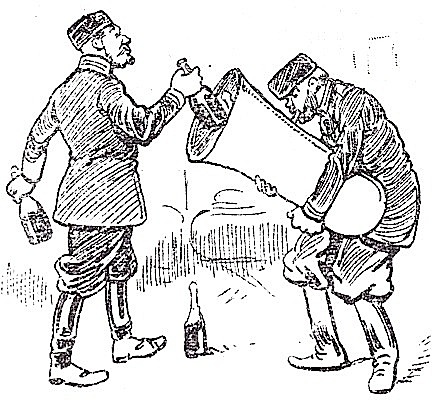I recently added 16 more images of serpents and ophicleides to the post Serpents & Ophicleides: History and Images, bringing the total to 120 images. I’m not sure if you can find that many historical pictures of serpents and ophicleides anywhere else, at least in any one place. Are there any trends to be seen in the depictions? Well, first of all, they are overwhelmingly French. Second, it is easy to divide the pictures into two broad categories: religious and military. Third, in the mid-to-late 19th century, you start to see more and more humorous depictions and caricatures, which is a trend I think you can see in music iconography in general. Here are the 16 new images, along with their captions:
c. 1590—Milan, Italy: Aurelio Luini depicts a cherub concert in his fresco in Milan’s San Simpliciano. The cherub to the immediate right of the trombonist may be playing a very small serpent (see below image; public domain) (Kendrick, Sounds of Milan 77 [black & white version]).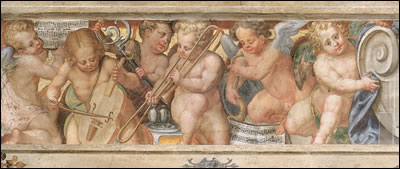
1762-1765—Paris, France: Denis Diderot includes the below graphic of the serpent in his famous Encyclopédie (see below image; public domain).
1809-1837—France: A printed entitled Planche de militaires, published by Jean-Baptiste Castiaux, includes a depiction of a military serpent player (see below image; public domain) (Paris, Museum of Civilization in Europe and the Mediterranean).
1825-50—Strasbourg, France: A watercolor by Wurtz and Pees, part of a collection of military figurines, depicts a serpent player of the regiment of mounted grenadiers of the Imperial Guard (see below image; public domain) (Paris, musée de l’Armée).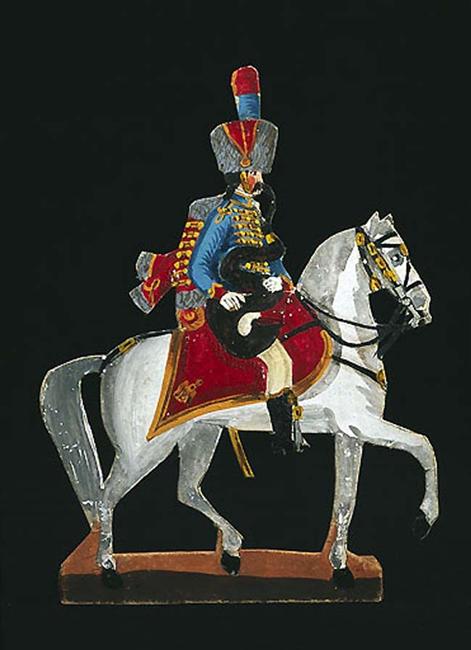
1825-50—Strasbourg, France: A watercolor by Wurtz and Pees, part of a collection of military figurines, includes depictions of 2 serpent players of the battalion of Neufchatel of 1808 (see below image; public domain) (Paris, musée de l’Armée).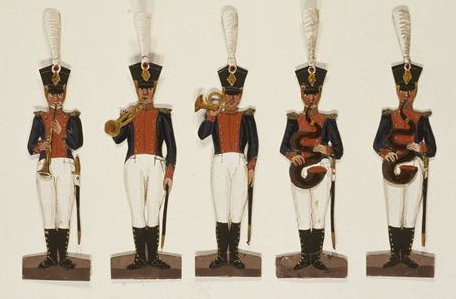
1825-50—Strasbourg, France: A watercolor by Wurtz and Pees, part of a collection of military figurines, includes a depiction of a serpent player on horseback with the 7th regiment of cuirassiers (see below image; public domain) (Paris, musée de l’Armée).
1825-50—Strasbourg, France: A watercolor by Wurtz and Pees, part of a collection of military figurines, includes a depiction of a serpent player with the musicians of the “régiment Irlandais, 1809-1811″ (see below detail; public domain) (Paris, musée de l’Armée).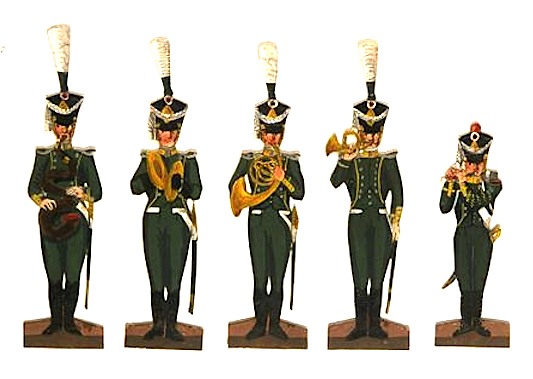
1825-1850—Strasbourg, France: The Wurtz and Pées family produces paper figurines of various military units. Among them are the below cavalry musicians, which include a serpent player (see below image; public domain).
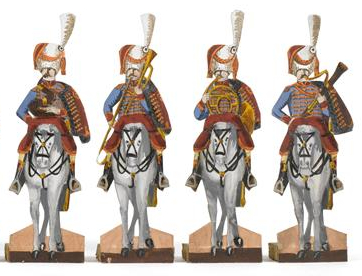
1850—An illustration features an ophicleide player from the Coldstream Guards Band in full uniform (see below image; public domain).
1850-1875—France: Musique d’infanterie française, a color lithograph printed by Pellerin, includes 3 ophicleide players among the infantry musicians (see below image–click picture for larger version; public domain) (Paris, Museum of European and Mediterranean Civilization).
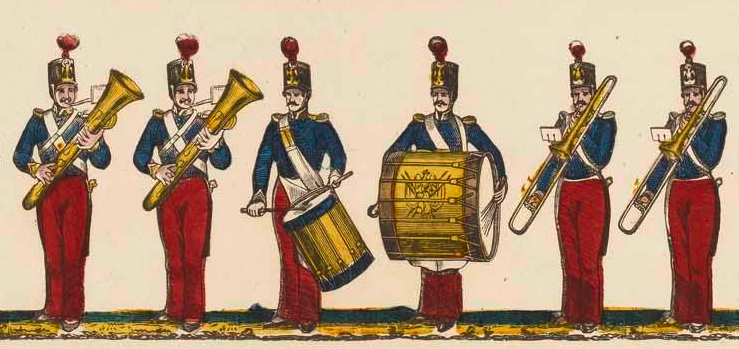
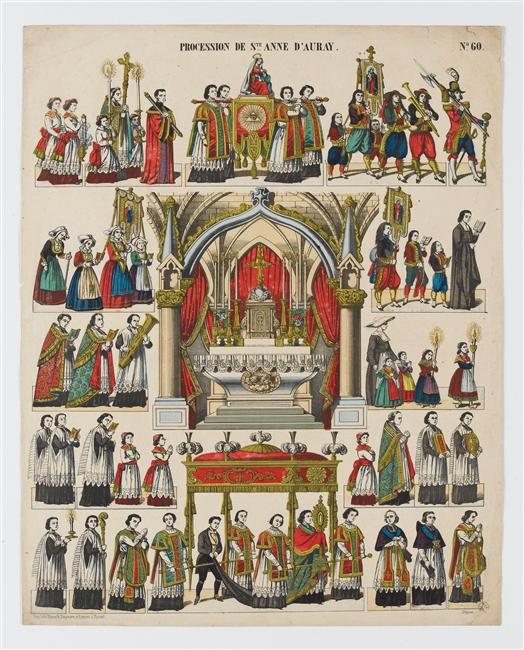
1862—Paris, France: A print by Jules Gaildrau entitled Fête des mécaniciens de la marine Impériale is published in the periodical L’Illustration. It includes an ophicleide among the band instruments at the celebration (see detail and full image below, after a sketch by Letuaire; public domain) (Dec 27, 1862, p. 432).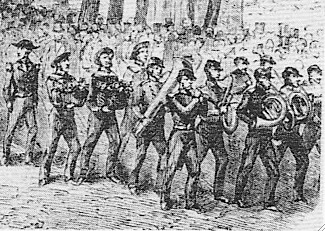
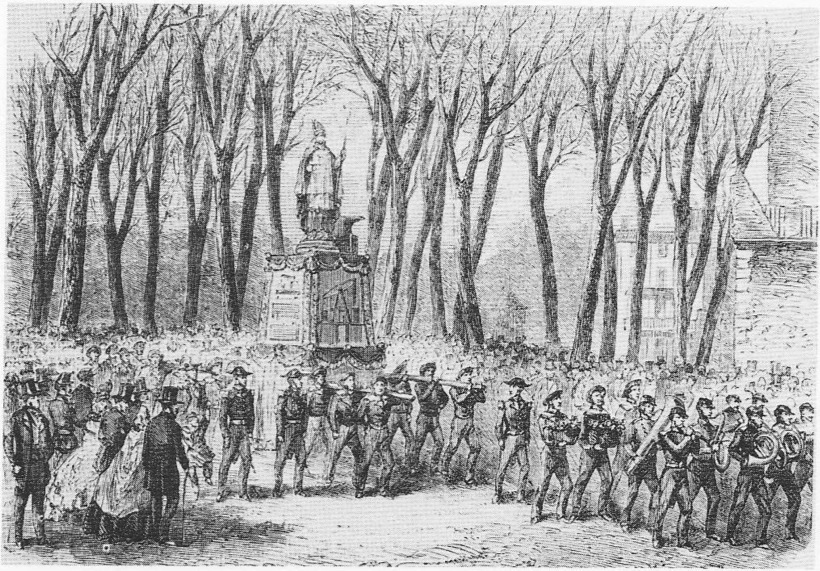
1867—Paris, France: A print after a drawing by Letuaire depicts the funeral convoy of Commander John Cornwall, US Navy, who died aboard the Miantonomah in Toulon Harbor. Among the musicians in the procession are a pair of ophicleides (see detail and full image below; public domain) (L’Illustration, March 2, 1867, p. 140).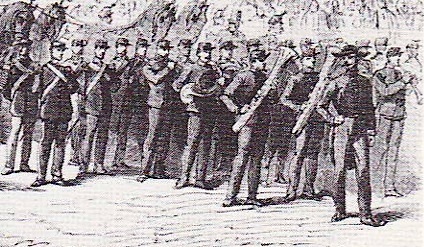

c. 1875—Paris, France: Choeur de six personnages en costume ecclésiastique devant un lutrin, a pen and ink drawing by French painter and illustrator Charles Henri Pille, features an ophicleide player accompanying 5 singers, all of them in religious garb (see below image; public domain) (Paris, The Louvre).
1897—Paris, France: A comic by Henriot (pseudonym for cartoonist Maigrot Henry) features an ophicleide being used to hold champagne by soldiers of the Préobrajensky regiment, a prestigious regiment of the Russian Imperial Guard. The caption reads, “La musique du régiment de Préobrajensky.—Encore des patriotes qui ont fourré dans ton ophicléide six bouteilles de champagne!—Je comprends maintenant pour quoi il ne voulait pas jouer!” (see below image; public domain) (L’Illustration, Nov 20, 1897).